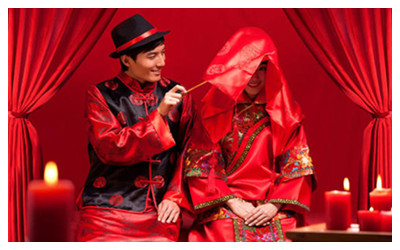Skype: neodalle-travel
Tel: +86 135 7447 2266
E-mail: sales@visitaroundchina.com

Chinese make substantial use of color symbolism. Colors play an important part in Chinese symbolism. Here is a list of the principal colors that are noted for their symbolism in Chinese art:
1. Red ( 红 hóng)
 Red is the color of blood and so by association the color of life itself. In opera a painted red face indicates divinity and heroism and is often used for Guandi the god of righteous action. In 1949, the Chinese people's Repulic was foundedafter Chinese Communist Party 's 22 years revelotion, so the red is also the symbol of Communism in China.
Red is the color of blood and so by association the color of life itself. In opera a painted red face indicates divinity and heroism and is often used for Guandi the god of righteous action. In 1949, the Chinese people's Repulic was foundedafter Chinese Communist Party 's 22 years revelotion, so the red is also the symbol of Communism in China.
In China, the red is the luckiest color and is widely seen at festivals and marriages to bring good luck and keep evil at bay. Charms written on red paper are plastered all over houses at Chinese New Year because according to legend the Nian monster is frightened by anything red. A traditional marriage custom is for the newly weds to drink from cups connected with a red thread.
3. Purple (紫 zǐ)
As in Rome, the color purple is associated with the Chinese Emperor because of its rarity and expense (Han purple). The Imperial capital district was formally called the the Purple Forbidden City which matches the Purple Forbidden Enclosure in the stars around the North pole. It came into widespread use at a late date and is not considered one of the five principal colors. In Chinese opera a face is painted purple to represent an incorruptible, loyal. In color symbolism it represents grief and introspection.
5. Blue (蓝 lán )
Generally the color blue has a negative connotation in China. Opera characters with blue make-up are usually ghosts or bad characters. Blue eyes, considered beautiful in the West, are very rare amongst Han Chinese. The wearing of blue flowers or ribbons in the hair is considered unlucky. However a bluebird is the messenger from the gods, principally associated with the Queen Mother of the West.
Pure blue is an expensive dye and for centuries a blueish-green was all that was available, this is called 青 qīng the character is used in the name of Qinghai province after the color of the lake from which it takes its name. As in other cultures separate words for ‘blue’ and ‘green’ were not originally used, qing was used for both colors. The cobalt blue that gave the deep pure colour to porcelain glazes only became available in the Yuan dynasty when it was imported from Persia.
Kuixing the god of examinations is painted with a blue face and, as he committed suicide, he is not a particularly lucky figure. Studying into the night was called to ‘study under the blue lamp’ and blue was the color associated with scholars; blue was used as the color for the sedan chairs of one grade of senior officials.
6. Black (黑 hēi)
Black denotes darkness and death but also honor; so in Chinese opera a blackened face is used for grim but honorable characters. The character for black (黑 hēi) originates from the process of producing soot which was then made into ink. The character represents a blackened window over a flame.
7. White (白 bái)
In China, the white is an unlucky color and also represents simplicit. The un-dyed cloth (specifically 素 sù) is white color to be often worn for funerals and mourning in contrast.
 Ask Questions ?
Ask Questions ?